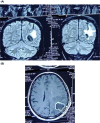Cerebral phaeohyphomycosis in liver transplant recipient: A case report
- PMID: 36483863
- PMCID: PMC9723403
- DOI: 10.1002/ccr3.6691
Cerebral phaeohyphomycosis in liver transplant recipient: A case report
Abstract
Cerebral phaeohyphomycosis is a fungal brain infection with a high fatality rate. It is caused by dematiaceous fungi and is increasingly recognized as a cause of serious illness in both immunocompetent and immunocompromised patients. We report cerebral phaeohyphomycosis in a liver transplant recipient. He was treated with multiple surgeries and antifungals and made a complete recovery. This report highlights that early and aggressive surgical intervention and extended antifungal coverage can have a positive outcome even in immunocompromised patients. The fungal infection in immunocompromised patients should be considered and treated aggressively.
Keywords: Rhinocladiella mackenziei; brain; fungal infection; immunocompromised; pathogens.
© 2022 The Authors. Clinical Case Reports published by John Wiley & Sons Ltd.
Conflict of interest statement
None.
Figures
Similar articles
-
Disseminated Rhinocladiella mackenziei infection in a kidney transplant recipient: A case report and literature review.J Mycol Med. 2021 Dec;31(4):101196. doi: 10.1016/j.mycmed.2021.101196. Epub 2021 Aug 12. J Mycol Med. 2021. PMID: 34418686 Review.
-
Fungal thalamic abscess caused by Rhinocladiella mackenziei in an immunocompetent patient.Indian J Med Microbiol. 2024 May-Jun;49:100605. doi: 10.1016/j.ijmmb.2024.100605. Epub 2024 May 23. Indian J Med Microbiol. 2024. PMID: 38734140
-
Cerebral phaeohyphomycosis due to Rhinocladiella mackenziei in an immunocompetent patient: A case report and review of literature.Curr Med Mycol. 2020 Sep;6(3):65-68. doi: 10.18502/CMM.6.3.4497. Curr Med Mycol. 2020. PMID: 33834146 Free PMC article.
-
Cerebral phaeohyphomycosis due to Rhinocladiella mackenziei in Persian Gulf region: A case and review.Mycoses. 2018 Apr;61(4):261-265. doi: 10.1111/myc.12734. Epub 2018 Jan 3. Mycoses. 2018. PMID: 29205524 Review.
-
Cerebral phaeohyphomycosis due to Rhinocladiella mackenziei (formerly Ramichloridium mackenziei): a taxonomic update and review of the literature.Med Mycol. 2010 May;48(3):546-56. doi: 10.3109/13693780903383914. Med Mycol. 2010. PMID: 19886775
References
-
- Kantarcioglu AS, de Hoog GS. Infections of the central nervous system by melanized fungi: a review of cases presented between 1999 and 2004. Mycoses. 2004;47(1–2):4‐13. - PubMed
-
- Revankar SG, Sutton DA, Rinaldi MG. Primary central nervous system phaeohyphomycosis: a review of 101 cases. Clin Infect Dis. 2004;38(2):206‐216. - PubMed
-
- Naim‐ur‐Rahman MES, Chagla AH. Fatal brain abscesses caused by Ramichloridium obovoideum: report of three cases. Acta Neurochir. 1988;93(3–4):92‐95. - PubMed
Publication types
LinkOut - more resources
Full Text Sources



